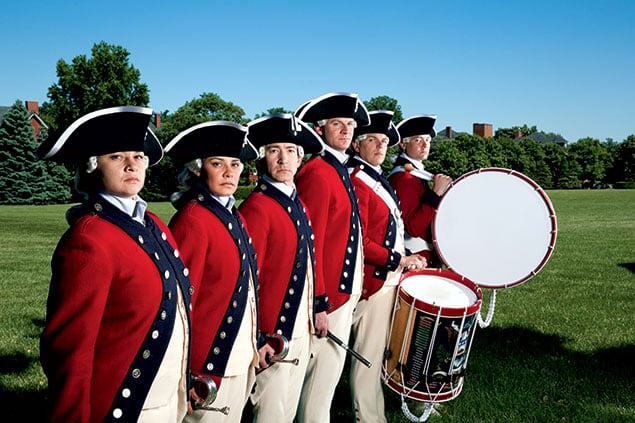Full-Screen Slideshow: Living History
These are not historical photographs.
Meet the US Army Old Guard Fife and Drum Corps. Based in Arlington’s Fort Myer, the 69-member military unit recreates the musical and military traditions of the American Revolution-era army. It has marched in every inaugural parade since JFK’s, performed for Presidents and dignitaries, and kept alive the vital role music has served in the military since George Washington’s day.
Members play ten-hole fifes, handmade drums, and bugles, just as their Colonial brethren did. Back then, fifers and drummers used a series of melodies and beats to relay orders from commanders across the battlefield—everything from advance to retreat, fire to cease fire, sweep left to sweep right—a tactic that can be traced to 15th-century Swiss mercenaries. The musicians were also an integral part of soldiers’ everyday life, signaling wake-up calls, mess calls, Sunday church calls, and more. “They even had a rum call for the soldiers to get their daily ration of rum to ward off scurvy and dysentery,” says Master Sergeant William White Jr., head drum major. White has been a part of fife-and-drum groups since he was ten, starting with the Colonial Williamsburg Fife and Drum Corps, where his father was a director.
Rum calls faded, and for years the fife-and-drum tradition did, too. The modern Corps began in 1960, as a provisional unit drawing volunteers from other groups. “Someone higher up got wind of it [soon after] and decided it was a waste of money,” White says. That’s when the lieutenant in charge of the Corps heard that Army Secretary Wilbur Brucker had a birthday coming up and arranged for the Corps to show up on Brucker’s lawn that morning to play “Happy Birthday.” The next day, not only was there permission for the Corps to continue, but there was funding for uniforms and instruments.
Since then, the Corps has performed about 500 times a year in venues such as the White House and the Pentagon and at economic summits, the Kentucky Derby, the Super Bowl, the Olympics, and more. It has become one of the most competitive band posts in the military, with nearly 40 musicians applying for a single recent opening.
“We’ve had fifers who saw the Corps when they were nine or ten, and this is the only thing they’ve wanted to do their entire life,” says Sergeant Major Gregory Rock. “The precision, the style, the music—not only is it patriotic, but there’s an awesomeness to the ceremony. People come up after a show and touch us, like to check if we’re real.”
Rock joined as a bugler in 1988 and performed for 17 years before being promoted to leadership. His mother was a genealogist, and he grew up steeped in his native Leesburg’s Civil War past. Donning period costumes and playing 18th-century music was a chance to experience history in a new way. “I think I was born 200 years too late,” Rock says.
Uniforms are designed as they would have been during the Revolution, circa 1781, albeit with slight modifications—for instance, the pewter buttons proved too brittle and were replaced with aluminum. But the coats are still 100-percent wool, as they were centuries ago. Their deep-red color is a tradition as well: Field musicians wore different colors than their unit so commanders could find them quickly to issue orders. The band’s drums are still handmade, and the drum major’s light-infantry-style cap is still covered in bear fur.
The Fife and Drum Corps of old had another duty just as important as giving orders: building morale. It’s this aspect, White says, that most strongly carries on. He recalls a performance for wounded warriors at Walter Reed Army Medical Center in 2004. Afterward, one of the patients, an Army chaplain, approached him: “He told me, ‘This is really the best, the most tangible reminder we have of the values and traditions the United States was founded on, and the reason we still need to be prepared to defend it today.’
“We tend to be confronted with cynicism on a daily basis,” White says. “But the unique presentation we provide—the instruments, the music, the costumes—reaches deep inside. It reminds folks that ultimately the United States is a great place to be.”
This article appears in the July 2013 issue of The Washingtonian.



















